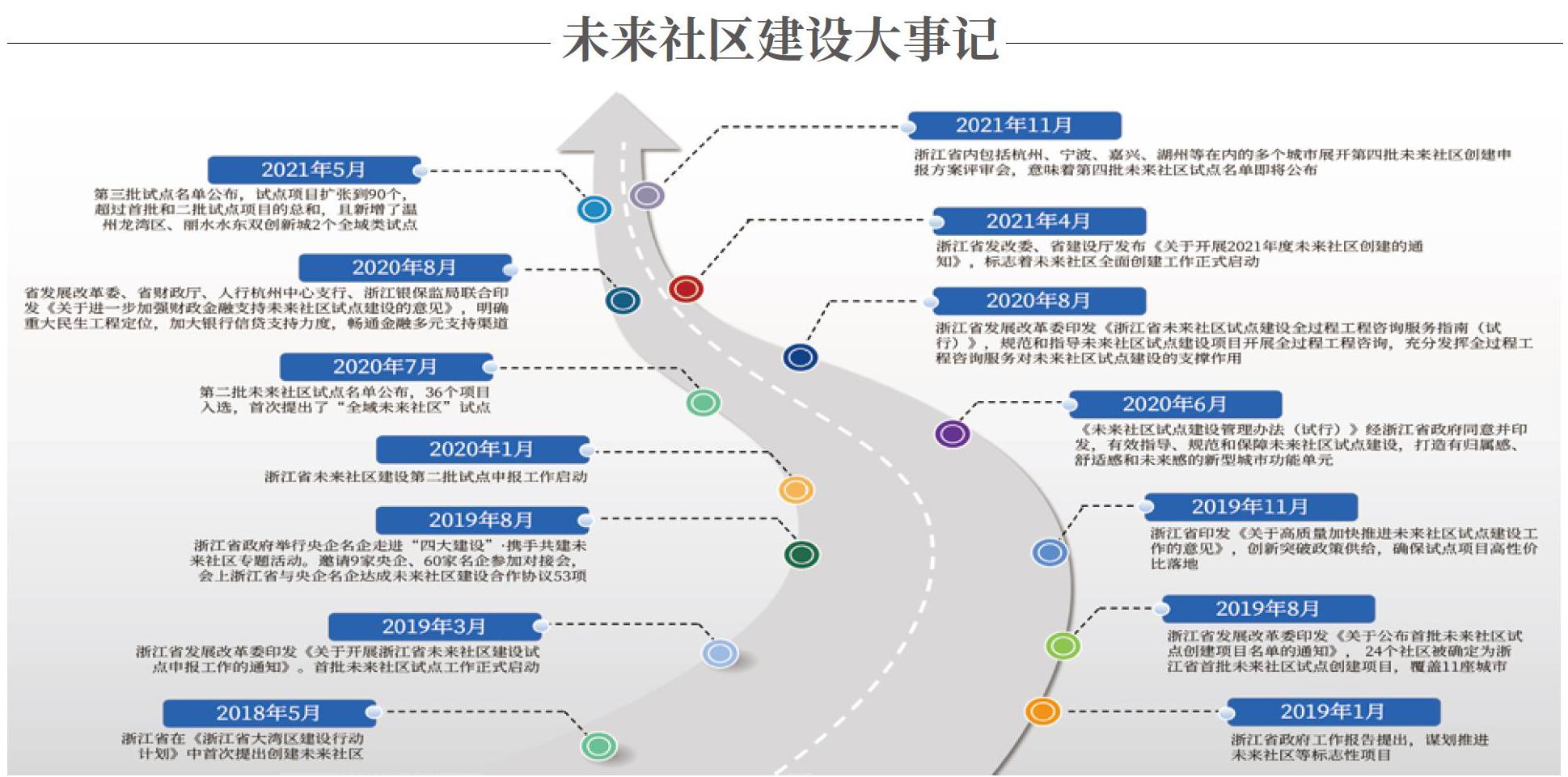浙江打造未来社区新样板
金少策 徐露路 马克强 张涵涵

如何让城市和社区变得更聪明、更智慧?新一轮科技革命和产业变革已然来临,社区的未来在哪里?
或许我们可以从浙江省的未来社区建设中获得答案。
在2019年召开的浙江省两会上,“未来社区”被正式写入《政府工作报告》中。当年3月份,浙江省政府正式启动试点申报,并印发了《浙江省未来社区建设试点工作方案》(下称《方案》),对未来社区的内涵、目标作出了明确阐释。
作为浙江省城市现代化建设的一张金名片,未来社区目前已发布三批试点创建项目名单,其建设正由点到面全方位铺开,迄今已有150个试点项目,总投资6323亿元,直接受益居民63.8万人。目前,前三批社区试点已经陆续启动建设。到2021年底,浙江省的目标是将培育省级未来社区试点100个;2022年起,将在此基础上全面复制推广,夯实未来城市发展基础。
一连串的动作凸显了浙江打造未来社区的雄心。秉承“以人为本、去房地产化”原则,浙江省要求未来社区建设既要落实“三化九场景”(即人本化、生态化、数字化这“三化”,以及邻里、教育、健康、创业、建筑、交通、低碳、服务、治理“九大场景”)系统配置要求,又要确保原居民“搬得进、住得起、过得好,让社区居民真正有获得感、幸福感、安全感”。
这将是一次对浙江城市发展质量的跨越式提升。面对旧城区多、改造任务重,又不能一律大拆大建的难题,浙江未来社区建设经过反复论证,秉承“最多改一次”的理念,并适度“留白”为城市功能迭代预留空间。同时,在谋划、建设中打破“瓶瓶罐罐”,一个个彰显地方特色的未来社区百花齐放、连点成片,终将塑造出“记得住过去,看得见未来”的高质量城市。
作为国内首次明确提出建设未来社区的省份,浙江开展的这场未来社区试点建设实验,将为社区治理带来怎样不同的风景?
为什么要建未来社区
说起未来社区,相信很多人还略显陌生。但是在国外却已有不少“未来社区”的示范先例。在加拿大,以建设更智能、绿色、包容的城市为目标,打造了Quayside未来社区。我们从欧洲BLOCK模式、新加坡COMPLEX模式、日本共享住宅中,也能看到未来社区的影子。
在国内,随着居民收入水平和城镇化水平的提升,居民对品质生活的需求也与日俱增。在未来社区项目提出之前,2018年12月,浙江省发改委曾牵头就未来社区建设展开了问卷调查。
问卷调查结果显示,社区存在重房地产轻人文、邻里关系淡漠、缺少文化交流载体平台等问题。“世界上最遥远的距离,不是相隔两地,而是你与我之间门对门,却谁都不认识谁”,这一感慨反映了现在楼越盖越高、人情却越来越淡薄的现象。社区医疗“看得起”但“看不好”,“最多只能看看小病”,以及由于人口密集、街道拥堵,一些停车难、公共交通出行不便、物流配送服务不完善等问题,也成为调查者希望改善的议题。
与此同时,在浙江快速城市化的进程中,一些“城市病”逐渐加剧。数据显示,1978年,浙江城市化率为14%,2018年全省城市化率已达68%,城市化程度增加近5倍。但是在城市规模逐步扩大的同时,与之相配套的社会保障、基础设施、生态环境虽得到一定的改善,但并未以正式的条例或文件进行规范、标准地建设。
人口增多、交通拥堵、环境恶化等社会问题衍生的“城市病”制约了城市化的发展。新旧社区发展参差不齐,许多老旧小区占据着城市发展的核心地段,出现市中心的“老破小”现象,不仅影响居住体验,也影响整个城市面貌。
这些小区的服务水平和建设品质也都相对低下,与城市文明发展要求严重不符,寻找城市高质量发展转型突破口已成当务之急。
凭借多年社区建设经验,浙江创造性地提出建设“未来社区”项目,在解决民生问题的同时,为社区的未来注入新的活力。
规划中的未来社区充满“魔幻气息”,以智慧共享为内涵,互联网、物联网、大数据、云计算、人工智能等先进技术的应用与推广,正好契合新一轮科技与产业革命所孕育的万物互联智能化时代风向标。
顺应民生、社会、时代三方面的客观要求,“未来社区”得以提出并实施建设,既是当下的问题,也是未来的方向;既是民心所向,也是大势所趋。
为什么是浙江
社区迭代、技术升级是中国城市化进程中的普遍课题,为何浙江省能在国内率先提出建设未来社区?
这是由浙江的城市化发展基础、社会发展环境条件、民众需求等所决定的。
首先,经过几十年的发展,浙江省城市化发展已达到一个较高水平,2019年时,全省城镇化率已突破70%,城市社区建设基础很坚实。
其次,浙江省的经济社会发展基本具备了相关条件,可以追求更高质量的城市化水平。以数字产业为例,数字经济是推动浙江高质量发展的“一号工程”,2019年浙江省数字经济核心产业增加值增长15%,占地区生产总值比重的10%。在《方案》中,数字化是建设未来社区三个价值导向之一(另两个是生态化、人本化)。
从民众角度而言,未来社区建设的需求也是迫切的,老旧小区的居民需要改善生活品质,而且新社区建设也亟须应用社区建设新理念和现代科技手段,为生活方式变革赋能。
从吸引人才角度来说,未来社区是推进浙江城市化水平高质量提升的标志性项目之一,对人才有很高需求,自然也需要有相应的高质量的社区来“接住”人才,未来社区正好提供了这樣一个平台。
习近平总书记在浙江考察时,赋予浙江“努力成为新时代全面展示中国特色社会主义制度优越性的重要窗口”的新目标新定位。对此,未来社区建设将全面注重未来社区价值内涵提升,主动对标老百姓美好生活需要。既体现“未来”,又力求“朴素”,让老百姓在彰显社会主义制度优越性的未来社区治理环境中,体验生活方式转变带来实实在在的好处。
从《方案》看,浙江省的未来社区建设提供了一种统筹性眼光,以人民美好生活向往为中心,注重人的全面发展需求,融合了社区软硬性设施标准与社会治理服务。
《方案》里提出的构建未来邻里、教育、健康、创业、建筑、交通、低碳、服务和治理等九大场景,是按照居民全生活链需求,把社区里复杂的各个系统贯通并有机集成,通过全功能链的对接以及全产业链的支撑,促使社区形成高效集成的生活服务综合平台,这对城市建设、城市管理也有很大的示范意义。
未来社区的重要特征,是以社区生活圈为单元来构建社区系统,相比一般意义上行政管理的社区概念,生活设施配置更为科学、系统和有效。未来社区的建设,将带动周边社区基础设施、社区服务乃至产业转型上的联动发展,进而推动整个区域发展。此外,未来社区引入数字管理系统,能产生更高的管理效率,覆盖范围也更广,可以推进社区治理水平的提高,缓解社区管理人才不足的矛盾。
为什么要以人为本
依据《方案》,人本化是未来社区的价值导向之一,这一点是浙江未来社区建设中贯彻始终的核心理念。
人本化的价值导向将贯穿浙江未来社区九大场景的建设,特别是邻里、教育、健康、服务等场景,它体现了以人为中心的社区建设理念。
比如以前建设社区的方案大多注重鸟瞰图效果,而浙江未来社区则选取人的场景图来参考,一切场景都围绕人们5—10—15分钟社区生活圈的需求来设计。
早在2000年10月27日,在杭州第一届“西博会”上,良渚文化村项目签约,开启了一场长达21年的“未来社区”试验。在项目打造之初,社区的设计者就画下一幅未来蓝图:文化村将被打造成一个拥有5个湖泊、6个公园,以步行5分钟的距离建立配套服务体系,以每小时5公里的步行速度建立的宜居小镇。在以人的全面发展和社会全面进步为导向的探索下,良渚文化村社区超前布局了邻里共享、智慧服务、生态低碳、产居共融等各个要素,构筑人与自然、人与生活的全新关系和场景,勾起人们对未来生活的更大期待与向往——通过全域景区化打造,释放山水田园生态优势,成为全省首批15个低碳社区之一;以《村民公约》开自治先河,打造独具特色的邻里文化,激发基层治理活力,树立社区治理的标杆;优化周边配套建设,社区周边不仅有良渚博物院、大雄寺等人文地标,良渚文化艺术中心、玉鸟流苏文化创意产业园等创新基地,也有浙一门诊部、随园嘉树养老公寓等民生配套。
当浙江省提出“未来社区”的“三化九场景”顶层设计时,良渚文化村人心里是有些自豪的:未来社区的“九大场景”,不少在社区里早已是触手可及的日常。
具体到社区试点项目,将以改造更新为主,兼顾规划新建。在首批24个试点社区里,21个是改造更新项目,改造更新主体锁定在20世纪70年代至90年代的老旧小区,因为未来社区建设的出发点是服务群众,老旧小区(住区)改造重建将作为试点的重要方向,让老旧小区群众率先改善生活,感受新时代新生活获得感。
此外,在改造过程中,还要维护好社区“原住民”的利益,留存社区原有文化肌理和历史记忆。
例如杭州上城区始版桥社区留有娃哈哈集团有限公司老生产基地的发展之根,承载着杭州人的工业记忆,在未来社区建设中,就保留了娃哈哈老厂房的烟囱、锅炉房等工业遗存建筑。
未来社区教育、健康等场景,与居民关切的医疗、养老、教育等民生问题相对应,未来社区建设提倡将医疗、教育等由各个部门分割管理的资源集中到社区。
具体到各个场景,目前未来社区试点与医院、学校等机构的联系工作已在开展,比如杭州拱墅区瓜山社区,正与杭州市二医院建立医联体,将为入住居民打造电子健康档案。
《方案》中明确提出未来社区建设要“加强与关联龙头企业的合作,组建未来社区产业联盟”, 值得一提的是,未来社区试点项目推进,以市场化方式为主,政府发挥引导作用,因而政府成立未来社区产业联盟,面向央企、国企、民资、外资全面开放,相当于是为企业提供了一个平台,让相关企业以一个整体却保有自主权的形式参与到未来社区建设运营之中,实现全过程有序可控。
市场化未来社区建设方案的精髓是可复制可推广的,当然,各地经济发展水平和城市建设状况又存在差异性,不可能完全照搬浙江。因此,浙江未来社区是提供了一种参考模式,如果在其他地区落地,也将相应地作出調整。
未来社区将带来什么
“未来社区将为浙江带来四大红利:改善大民生,驱动大投资,带动大产业,促进大转型。”浙江省发改委负责人说。
首先,从大民生角度来看,未来社区将彻底解决老旧小区的“老大难”问题,引领未来生活方式的变革创新,提升人才落户吸引力;“邻里文化”与人文氛围的日渐浓厚,带来更为和谐亲密的邻里氛围,在有效和先进的社区管理体制下,更积极地参与社区志愿服务,不仅能打造更为舒适的生活环境,也能形成互帮互助的邻里友好关系,打造邻里互助生活共同体。
同时,未来社区基础设施与社会服务的极大完善,更加符合现代需求的社区空间规划,设计美观的实用建筑将从住宅角度给予居民更为安心舒适的居住体验。在未来社区“5、10、30 分钟出行圈”的打造理念下,居民交通出行更加方便快捷。
其次,未来社区建设还将拉动万亿级大投资,激活撬动民间投资。未来社区针对老旧社区的翻新改造,将从基础设施与公共服务入手,提高空间集约利用率,运用物联网技术关联基础设施,能够积极拉动社区周边水、电、气、交通各方面的建设需求,以需求撬动投资;对于规划新建的区域,将推行TOD理念(以公共交通为导向的开发),使公共空间成为建筑导向和邻里生活的焦点,以交通优势吸引社会各界尤其是民间投资加入。
再次,是带动大产业。未来社区所融合的人工智能、云计算等前沿技术将渗透于社区的公共服务、基础设施建设之中,其衍生出的数字经济价值将带动相关产业形成一个巨大的智能产业链。凭借着社区庞大的用户基数与对用户需求的精准把握,依托智能数据技术,实现30分钟配送入户,未来社区势必能通过成本和效率的优势拉动社区新零售的发展。
第四,是促進大转型。面对当前尚处粗放型的经济发展与城市管理模式所引发的资源浪费、生态破坏等问题,未来社区将以其高集约化的资源利用和集群化的管理模式,以及尖端技术的运用,有效促进经济发展由粗放型向集约型转型,由单一的管理模式向多元化、集成化转型。
可以说,浙江出招建设未来社区,不仅在民生领域解决了当前存在的诸多问题,更将成为产业领域中新市场转型发展的一大助推力,带来的是民生与市场、内外并存的多重红利。
“梦会开出花来的,梦会开出娇妍的花来的。”浙江省发改委固定资产投资处处长杜旭亮引用戴望舒的《寻梦者》中的一句诗,表达对未来社区建设的希冀。
Zhejiang’s New Models of Future Communities
By Jin Shaoce Xu Lulu Ma Keqiang Zhang Hanhan
How can we make cities and communities more intelligent and smarter? With the arrival of a new round of technological revolution and industrial transformation, what will be the future of the community?
Perhaps the answer can be found in Zhejiang province’s development of “future communities”.
During the “two sessions”— annual meetings of provincial lawmakers and political advisors — of Zhejiang province in 2019, the concept of “future communities” was officially written into the Government Work Report. In March that year, Zhejiang Provincial Government officially launched the pilot program for future communities, and issued the Zhejiang Province Future Community Construction Pilot Work Plan (hereinafter referred to as the Plan), articulating the significance and the intended goals of future communities.
So far, 150 pilot projects have been approved, with a total investment of 632.3 billion yuan, benefiting 638,000 residents directly. At present, work on the first three batches of pilot projects has already started. By the end of 2021, Zhejiang aims to nurture 100 provincial-level future communities, which will be promoted throughout the province starting in 2022, so as to lay a solid foundation for future urban development. Most importantly, Zhejiang will make sure that residents “move in smoothly and live here affordably and happily”, so that they will truly enjoy a sense of gain, happiness and security.
As the first province in China to propose the construction of future communities, what difference will the experimentation bring to the practice of community governance in Zhejiang?
When it comes to “future communities”, many readers might find it unfamiliar. However, examples and models of “future communities” abound outside of China, especially in developed countries, such as Quayside Future Community in Canada, created to build a smarter, green and inclusive city. Besides, the BLOCK model in Europe, the COMPLEX model in Singapore and shared housing in Japan are also variations of future communities.
In China, as residents’ income rises and urbanization forges on, the public demand for high-quality life is stronger by the day. Before the future community project was proposed, in December 2018, Zhejiang Provincial Development and Reform Commission conducted a survey on “future communities”.
The results showed a host of problems in residential communities, such as putting a premium on the economic value of real estate, weak neighbor relationships, a lack of cultural exchange platforms and inadequate community medical care. There were also issues arising from dense population, including street congestion, parking difficulties, inconvenient public transportation and poor delivery services.
Indeed, in Zhejiang’s rapid urbanization, some “urban diseases” gradually worsened. Statistics show that in 1978, Zhejiang’s urbanization rate was 14%, which nearly quadrupled in 2018, reaching 68%. However, as cities gradually expand and develop, social security, infrastructure and ecological environment are not catching up. The development of old and new communities is uneven, and since many old residential areas sit right in the core area of urban development, the phenomenon of “old, broken and cramped” (apartments) in the city center has emerged, adversely impacting on the living experience and the urban landscape. Thus, relying on years of experience in community construction, Zhejiang creatively put forward the project of building “future communities”, which will not only solve these problems, but also inject new vitality into the future of communities.
But why Zhejiang? Why of all places in China, it is Zhejiang that has taken the lead in building future communities? It boils down to Zhejiang’s robust urban development, social development as well as the popular demand. For one thing, the province’s urbanization has reached a high level; in 2019, its urbanization rate exceeded 70%. For another, Zhejiang’s economic and social development has enabled its pursuing high-quality development. Taking the digital industry as an example, the foremost industry to promote Zhejiang’s high-quality development. In 2019, its added value increased by 15%, accounting for 10% of the regional GDP.
The public demand for future communities is also urgent, particular those residents living in the old communities who need to improve the quality of life. As one of the landmark projects to promote Zhejiang’s high-quality development in urbanization, future communities are destined to attract various talents too.
When General Secretary Xi Jinping visited Zhejiang, he stated that Zhejiang should “strive to become an important window to fully display the superiority of the socialist system with Chinese characteristics in the new era”. To that end, Zhejiang’s development of future communities will focus on working to satisfy people’s pursuit of happiness. These future communities should both reflect the “future” and remain “simple” in that mindlessly chasing after “futuristic” and “trendy” appearances for the communities should be avoided at all costs, for the real benefits should all be accrued to the people.
In fact, people-centeredness is one of the central tenets in developing future communities in Zhejiang, which is both spelt out in the Plan and shown in its implementation. For example, most of the community construction schemes in the past would only look at the effect of an aerial view, while the future community projects in Zhejiang center on people, and all possible scenarios have been designed to meet people’s needs within a 5 to 10 to 15 minutes of community life circle.
In the future, future communities will bring four major benefits to Zhejiang: improving people’s livelihoods, spurring significant investment, driving industrial integration and promoting industrial transformation, according to the Zhejiang Provincial Development and Reform Commission. Indeed, apart from tackling the various existing problems caused by old communities, Zhejiang’s initiative to build “future communities” is supposed to bring in large flows of investment thanks to the demand they are expected to generate, help drive the formation of a digital-industry-powered industrial chain, and considerably improve efficiency and cut down on the waste that traditional management models give rise to.

